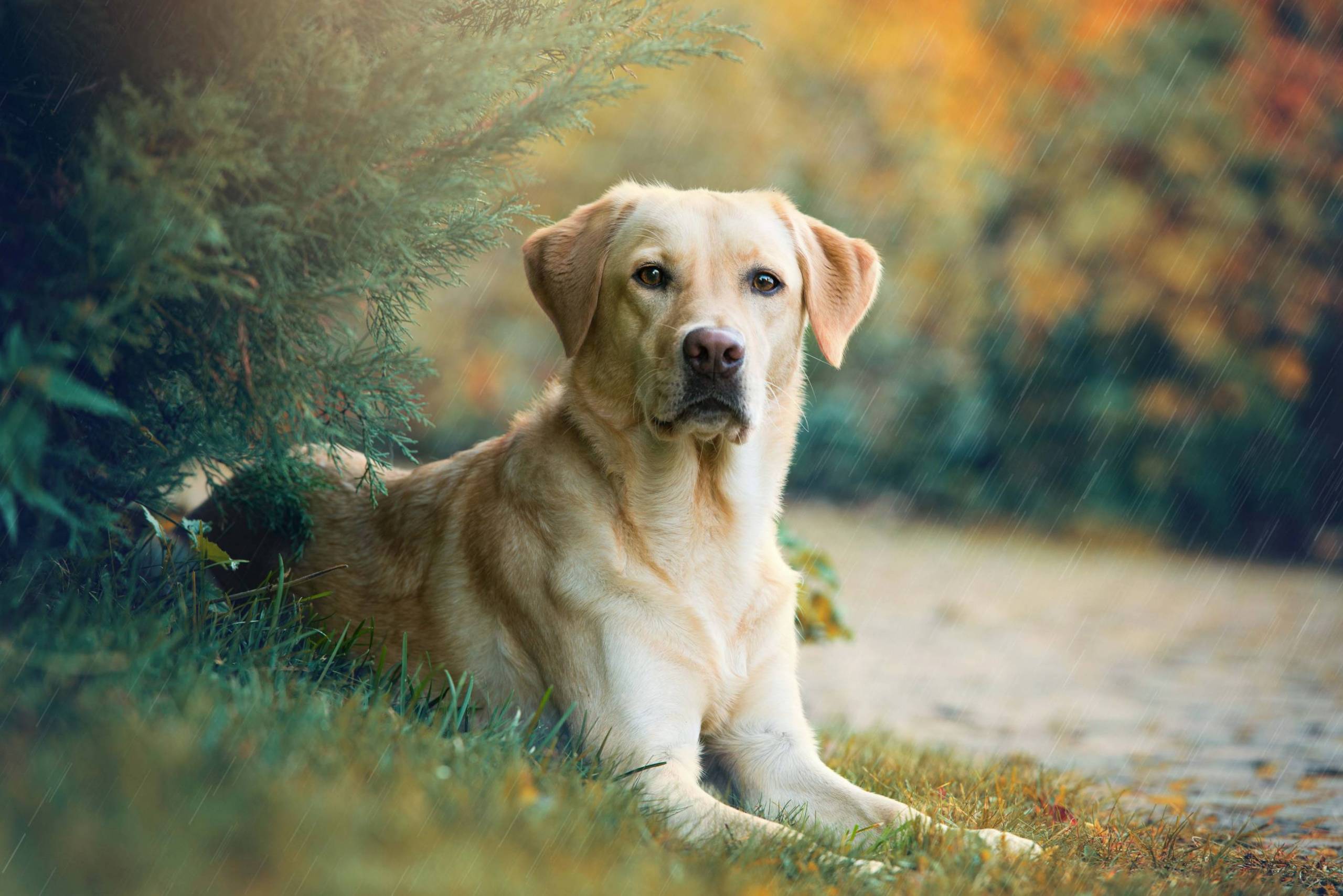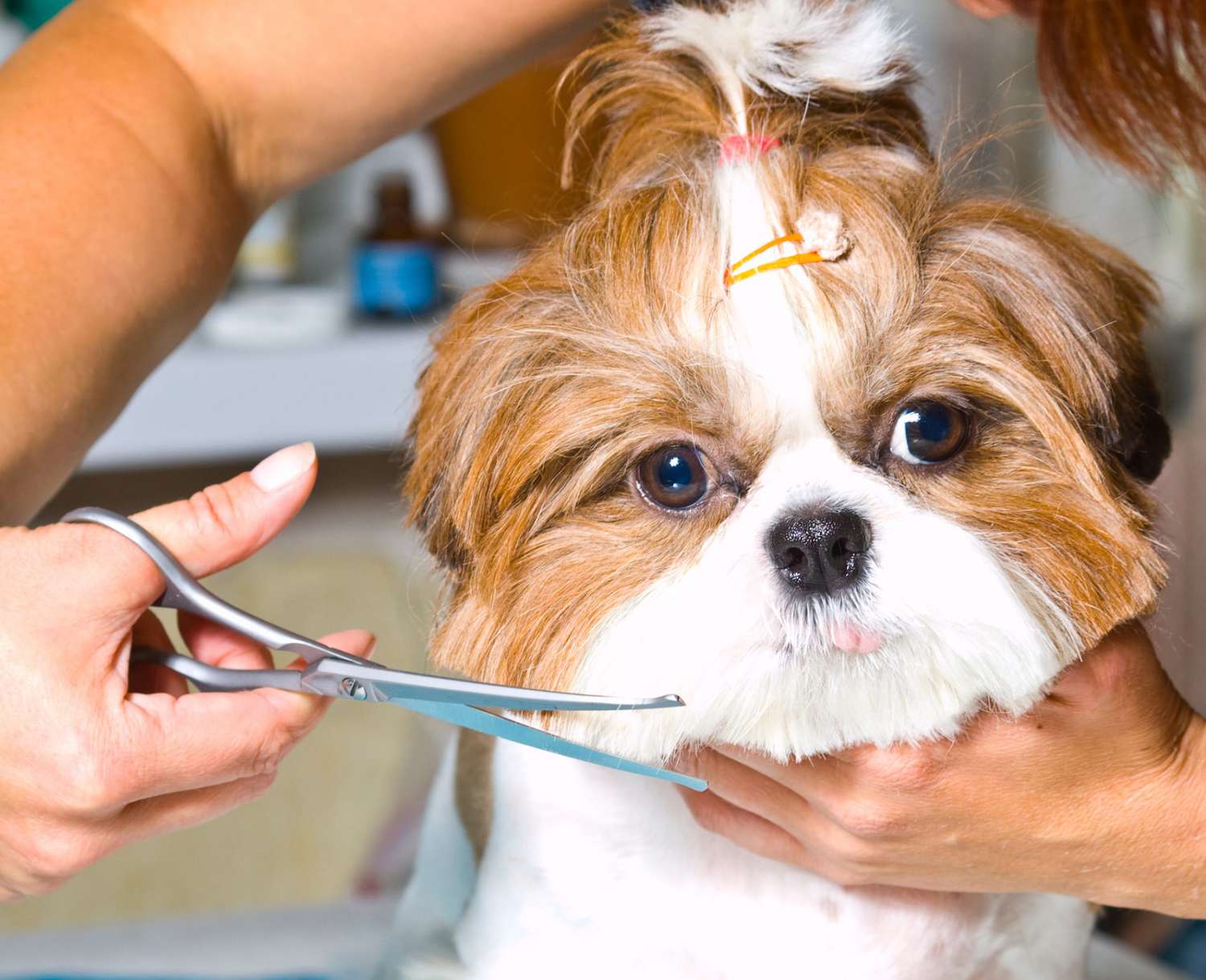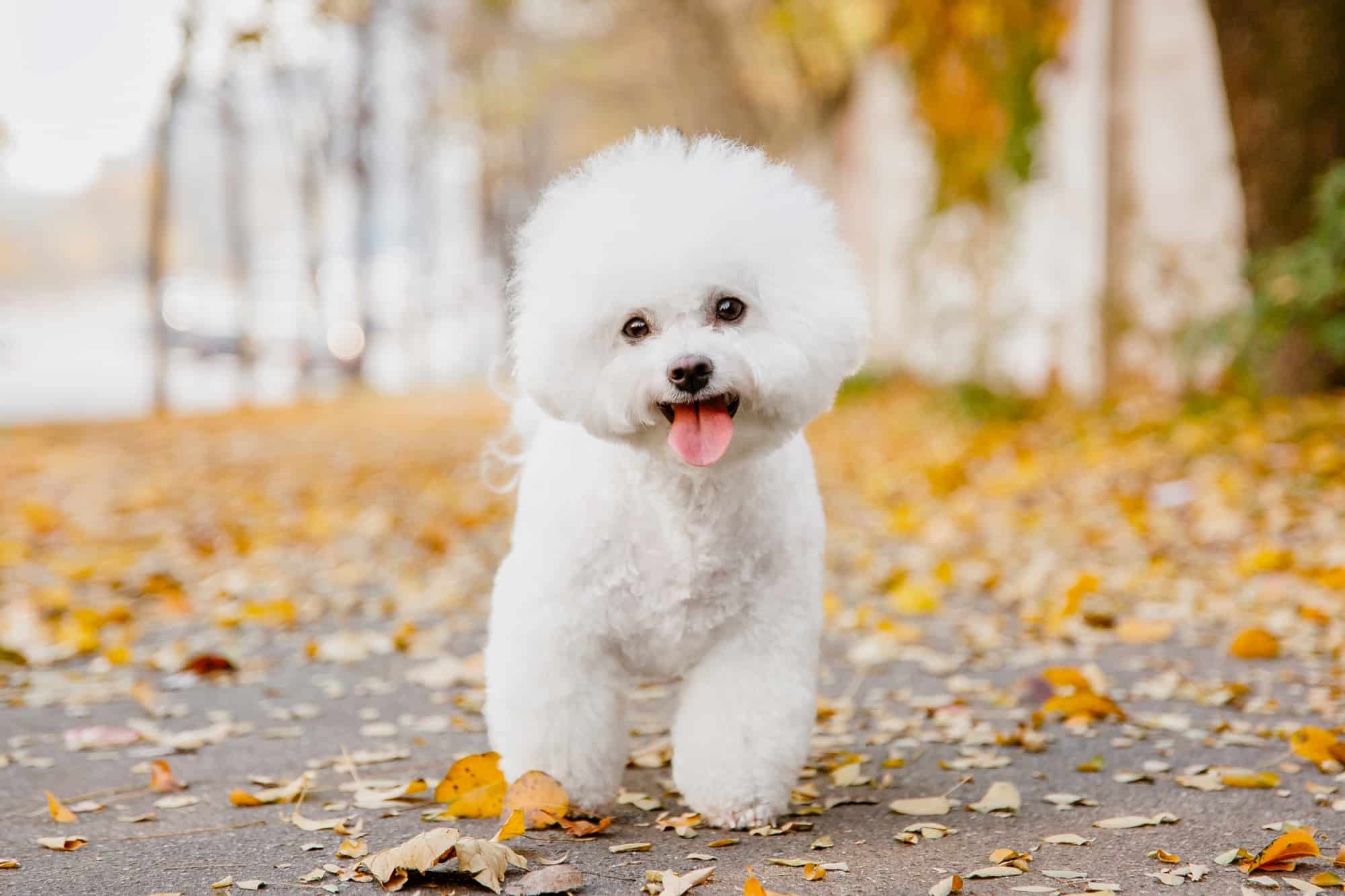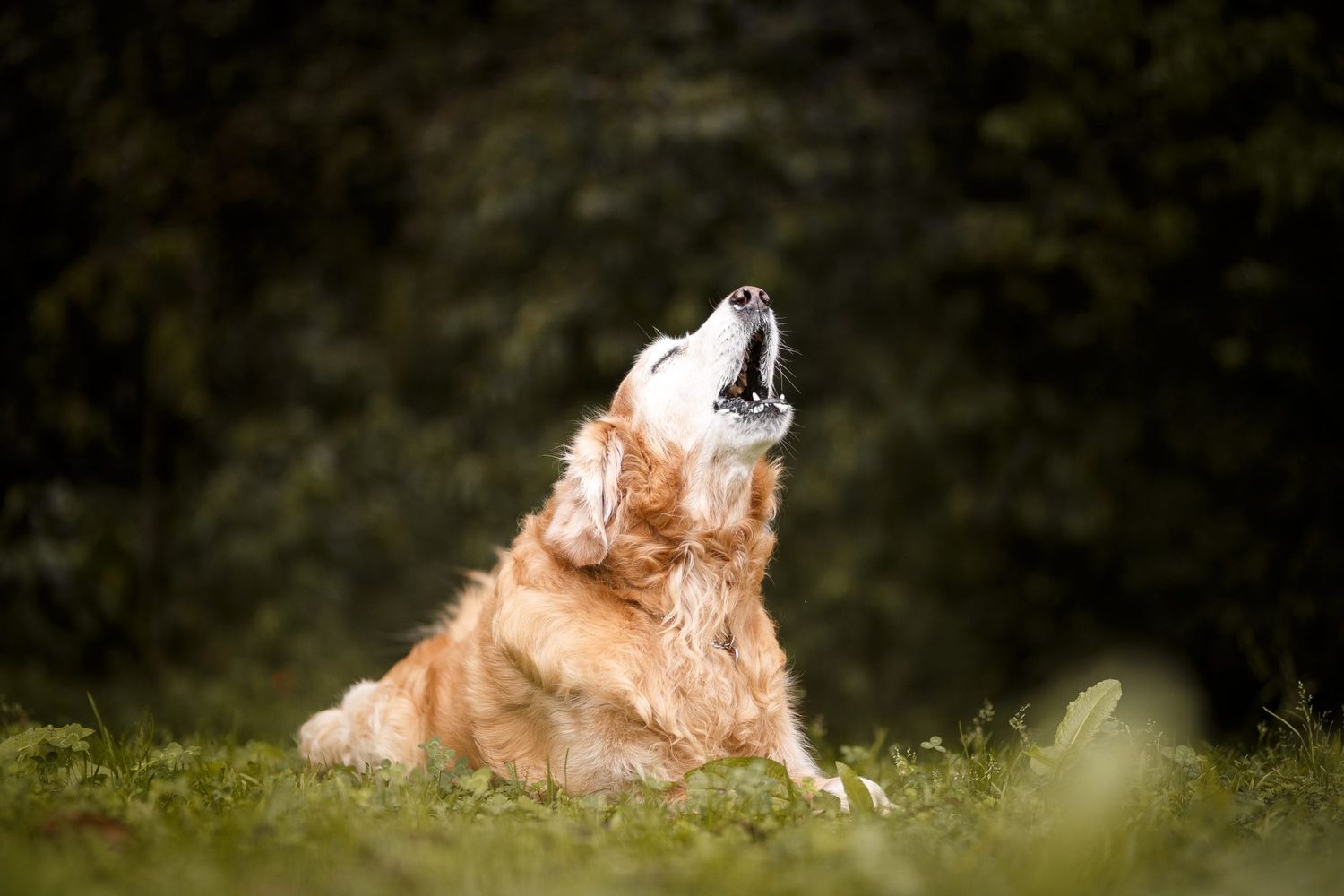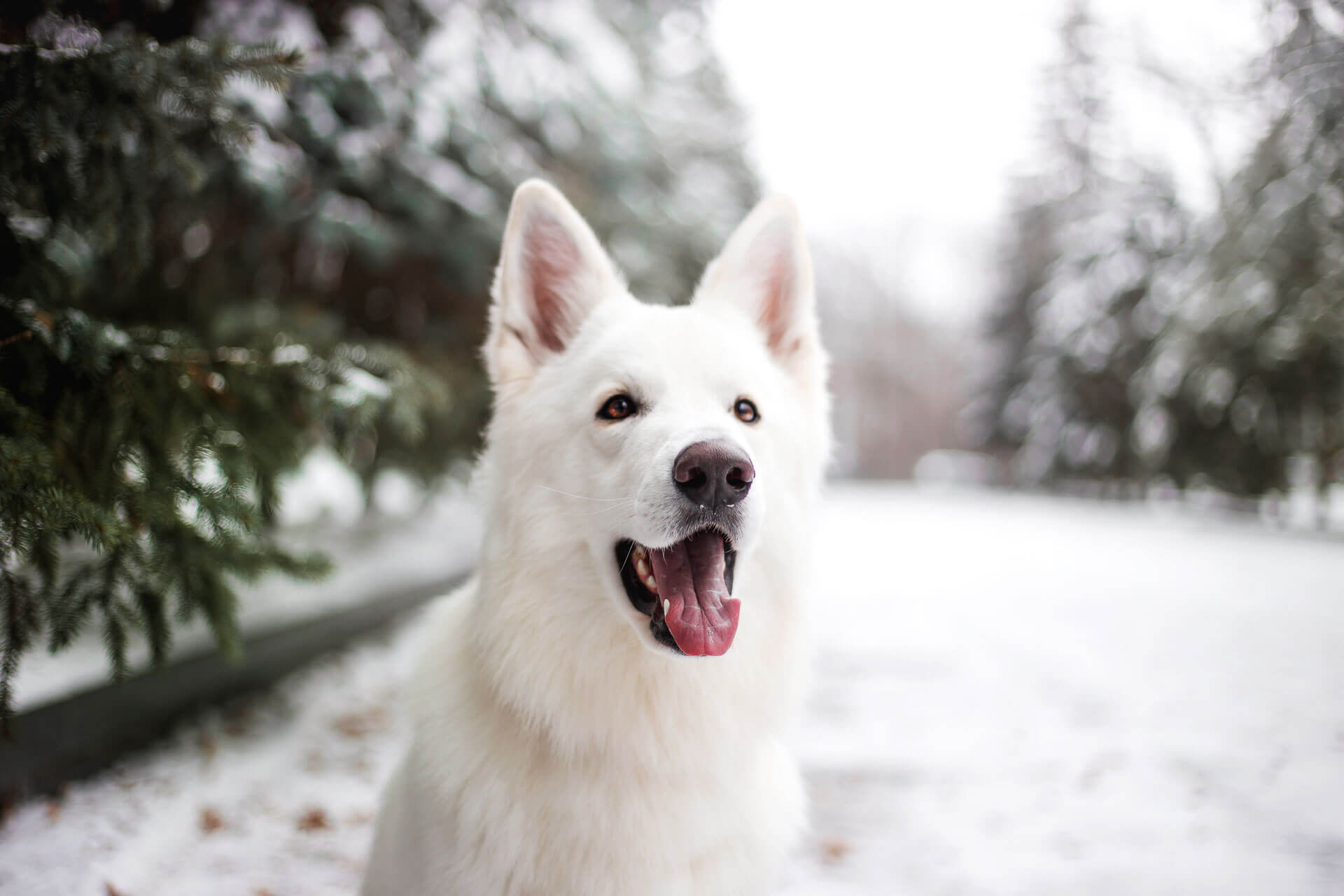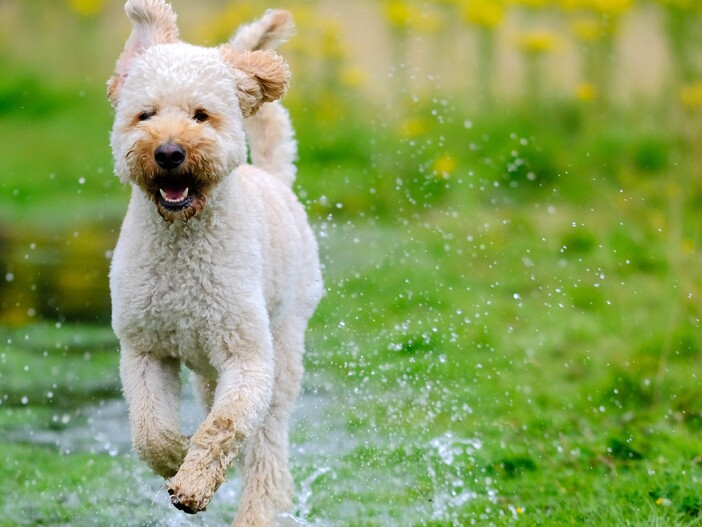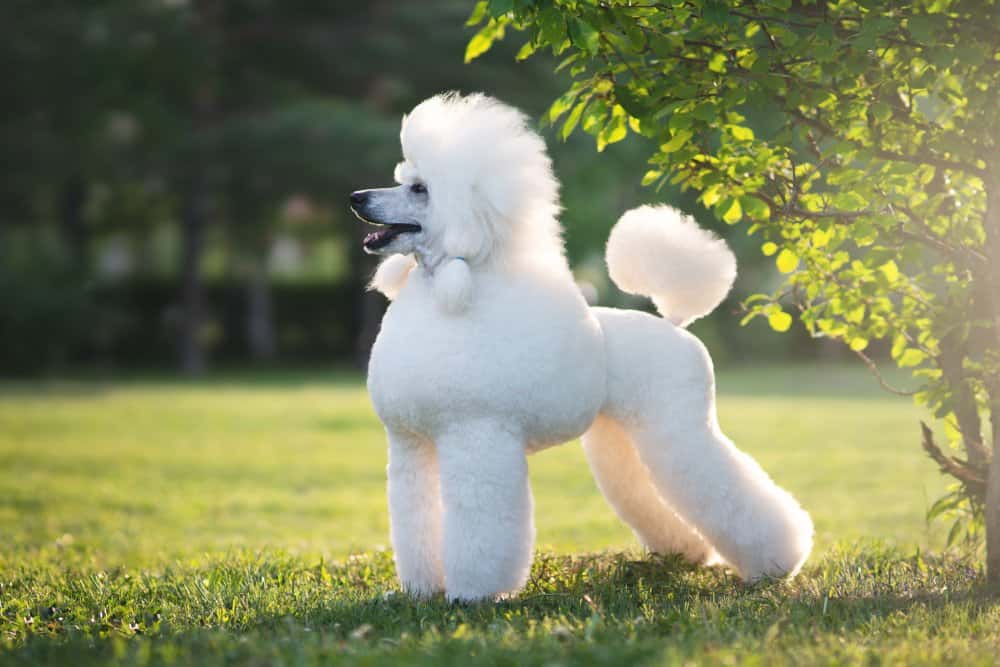If you’re a dog lover, you might be curious about the biggest dog breeds in the world. From ancient Roman war dogs to modern-day farm dogs, these breeds have been bred for their size and strength.
In this article, we’ll take a look at the top 15 biggest dog breeds in the world, according to various sources. We’ll also explore some interesting facts about each breed, including their origin, temperament, and exercise needs.
You are reading: The Top 15 Biggest Dogs In The World
Whether you’re looking for a new furry friend or just want to learn more about these gentle giants, read on to discover the world’s biggest dogs.
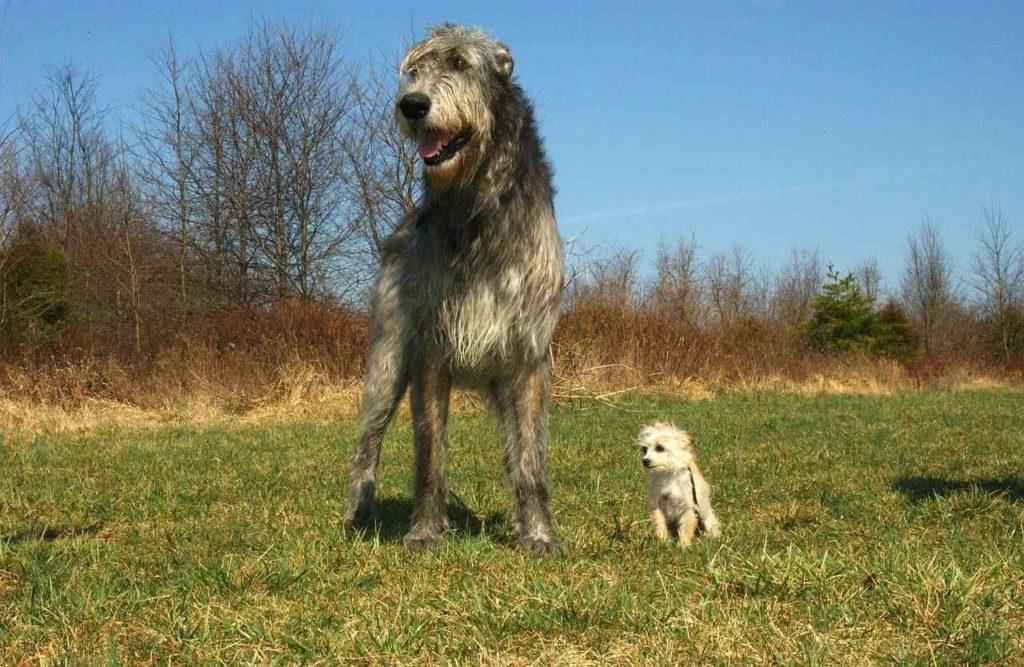
The Top 15 Biggest Dogs In The World
English Mastiff
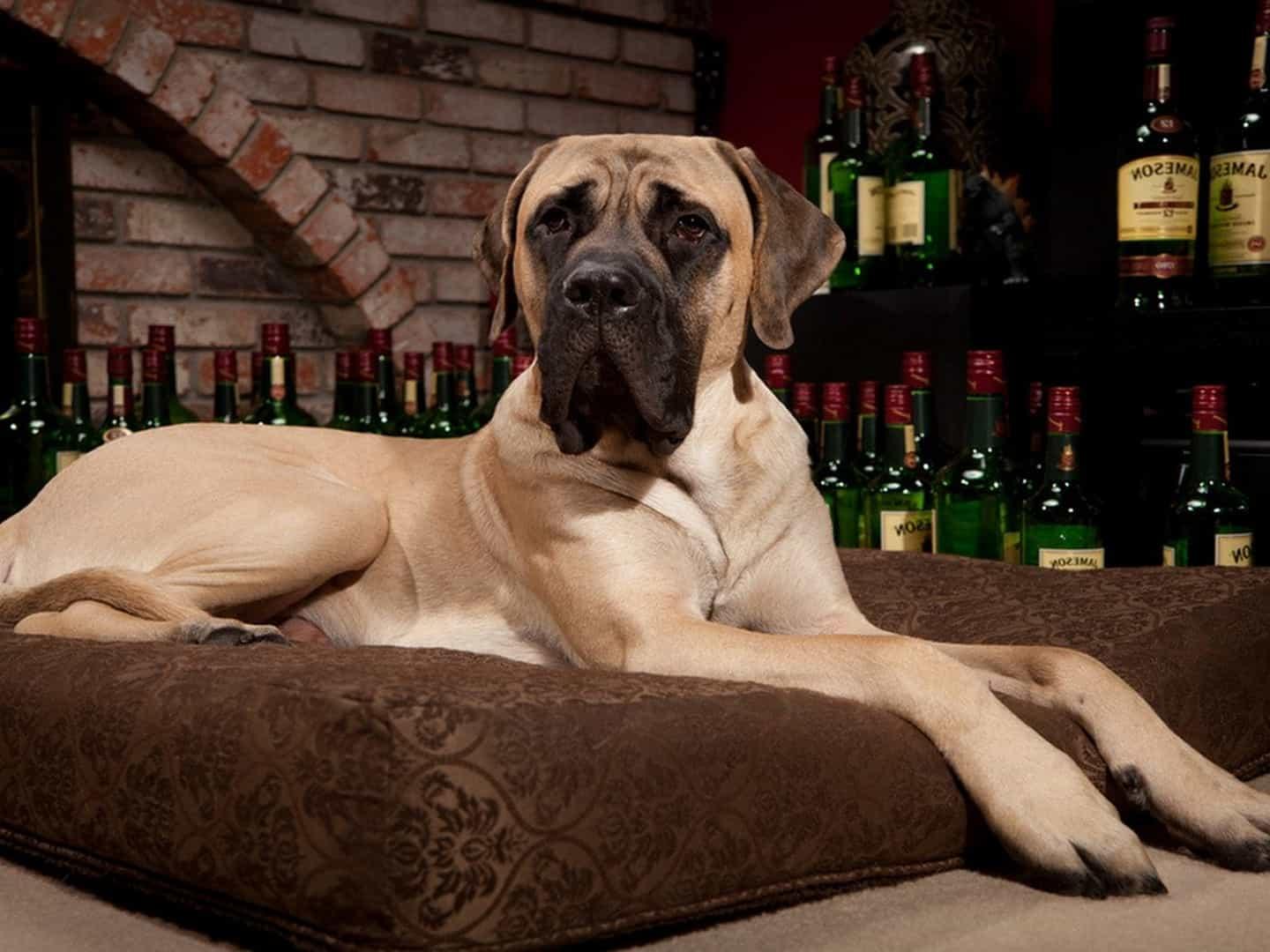
The English Mastiff, also known simply as the Mastiff, is a British dog breed that is known for its enormous size, massive head, and short coat in a limited range of colors, always displaying a black mask.
Appearance
– The Mastiff is a very massive, powerful, and muscular dog.
– They have a large, heavy, square head with a well-marked stop between the eyes.
– The muzzle should be half the length of the skull.
– The medium-sized brown to dark hazel eyes are set wide apart with a black mask around them.
– The nose is dark in color.
– The small, V-shaped ears are in proportion with the skull and are dark in color.
History
– The English Mastiff is a very old breed, depicted in Egyptian monuments as early as 3000 BC.
– The breed fought alongside British soldiers in 55 BC.
– Caesar brought a pack of Mastiffs to Rome where the dogs were put on display as arena gladiators and forced to be in fights with human gladiators, lions, bull baiting, bear baiting, and in dog-to-dog combat.
Temperament
– The Mastiff is noted for its gentle and loving nature.
– They are usually easygoing and good-natured, but they’re not pushovers to raise and train.
– Some are passively stubborn, while others have timidity or aggression.
– To ensure a stable temperament, English Mastiffs need earlier and more frequent socialization than many other breeds.
Size
– The English Mastiff is one of the largest dog breeds, with males weighing between 160-230 pounds (72-104 kg) .
– They can stand up to 30 inches (76 cm) tall at the shoulder.
Overall, the English Mastiff is a gentle giant that requires early socialization and training to ensure a stable temperament. They are known for their massive size and muscular build, making them an impressive sight to behold.
Boerboel
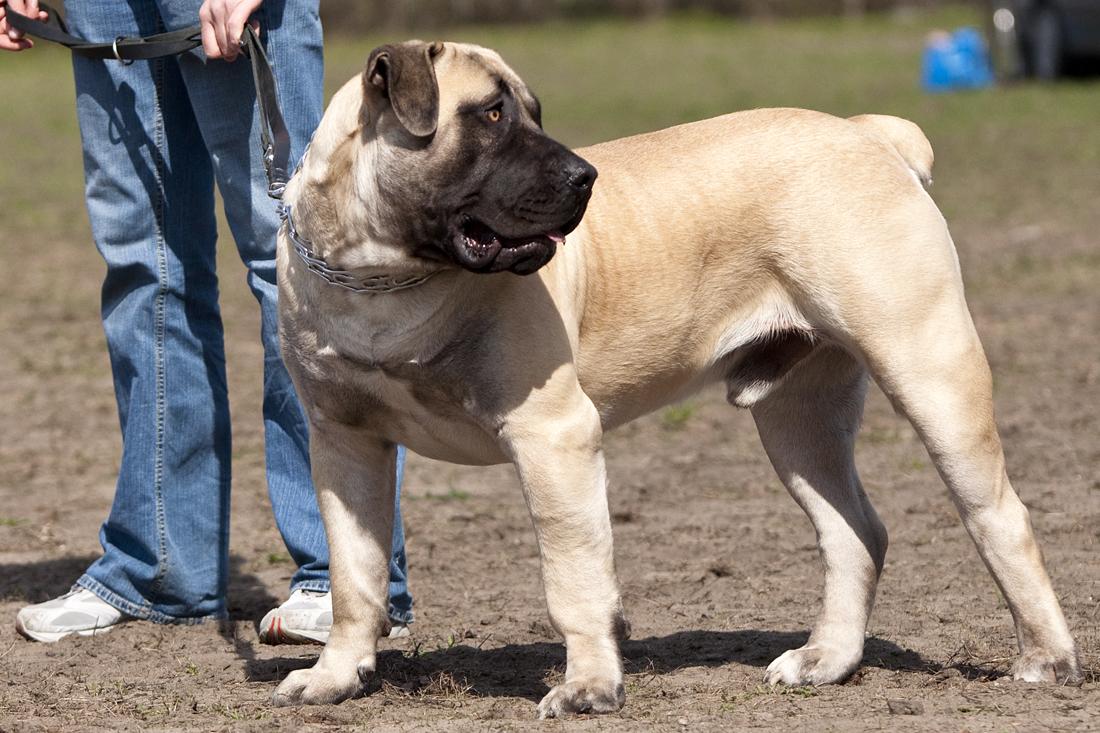
The Boerboel, also known as the South African Mastiff, is a large and muscular dog breed that originated in South Africa.
Appearance
– The Boerboel is a muscular and large dog with a broad, blocky head and broad muzzle.
– The neck is powerful and well-muscled, and the chest is long, broad, and deep.
– The coat is short, dense, smooth, and shiny, while the skin is thick and loose but fits smoothly.
– The breed comes in a variety of colors, including fawn, brindle, and black.
Temperament
– The Boerboel is a confident and affectionate dog that is loyal to its family.
– They are known for their protective instincts and can be wary of strangers and other dogs.
– Socialization and training from an early age are important for this breed.
– They are independent and confident, but consistent training is important for their development.
Size
– The Boerboel is a very large and strong-boned dog, with males weighing between 150-220 pounds (68-100 kg) and standing up to 27 inches (68 cm) tall at the shoulder.
Overall, the Boerboel is a loyal and affectionate dog that requires early socialization and consistent training. They are known for their protective instincts and impressive size, making them a great choice for experienced dog owners who are looking for a loyal and devoted companion.
Saint Bernard
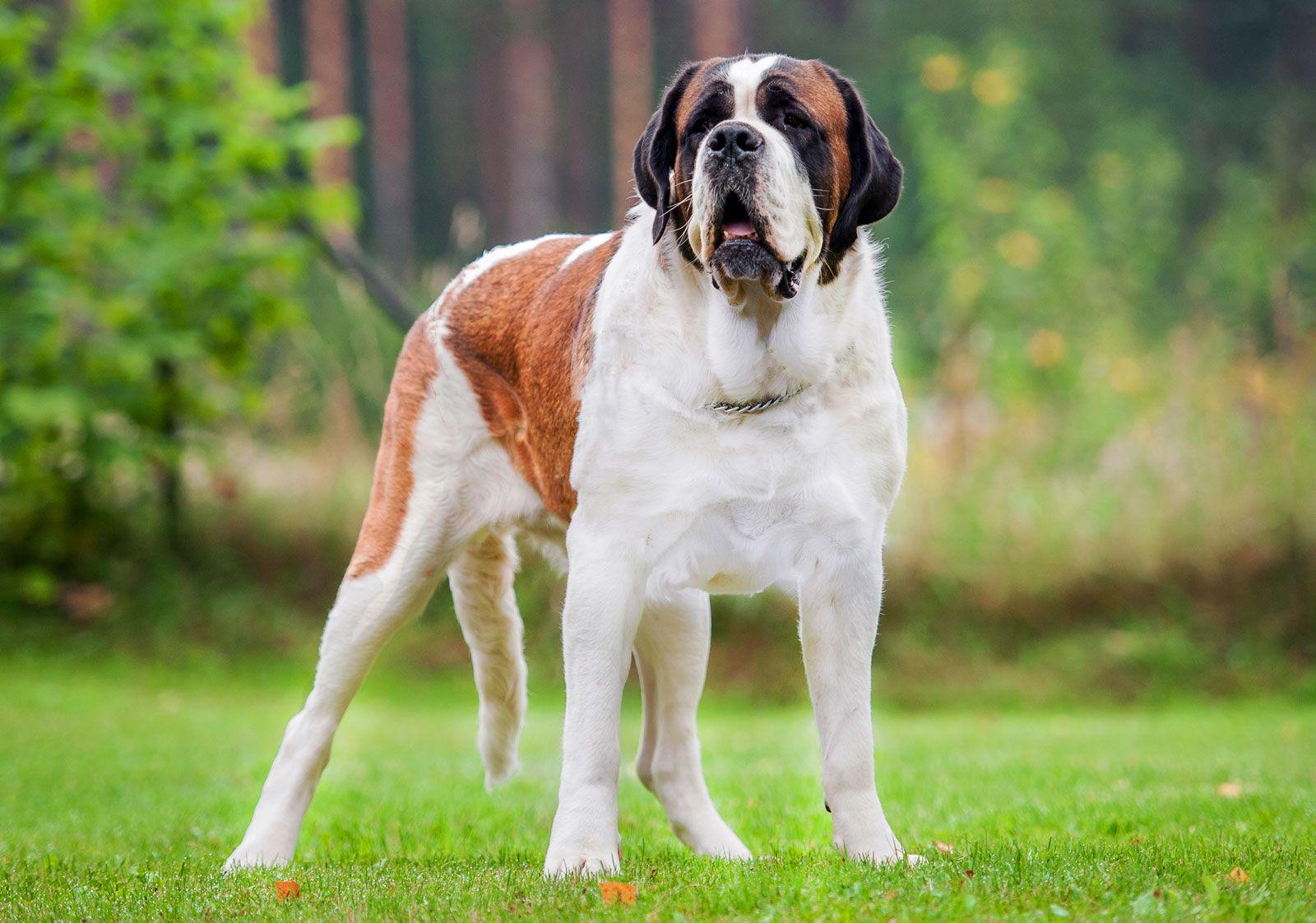
The Saint Bernard is a giant breed of dog that originated in the Western Alps in Italy and Switzerland.
Appearance
– The Saint Bernard is a very large, strong, and muscular dog.
– They have a massive head with a short, wide muzzle and broad nostrils.
– The medium-sized eyes are set somewhat to the sides and are dark in color.
– The coat is typically a red shade with white, or a mahogany brindle with white, and can be either smooth or rough.
– The breed has a long tail that hangs high.
Temperament
– The Saint Bernard is known for being extremely gentle, friendly, and tolerant of children.
– They are slow-moving, patient, obedient, and eager to please.
– The breed is highly intelligent and easy to train, but training should begin early while the dog is still a manageable size.
– Socialization with people and other animals is important for this breed.
History
– The Saint Bernard was originally bred for rescue work by the hospice of the Great St Bernard Pass on the Italian-Swiss border.
– The hospice, built by and named after the Alpine monk Saint Bernard of Menthon, acquired its first dogs between 1660 and 1670.
– The breed is credited with saving the lives of more than 2,000 people in 300 years of service as a pathfinder and rescue dog.
Size
– The Saint Bernard is a giant breed, with males standing 26 to 30 inches (66 to 76 cm) tall at the shoulder and weighing between 140-180 pounds (64-82 kg).
– The taller the dog, the more prized it is, as long as the weight stays in proportion with the height.
Overall, the Saint Bernard is a gentle giant that is known for its patient and obedient nature. They were originally bred for rescue work and have saved many lives over the years. The breed requires early socialization and consistent training to ensure a stable temperament.
Neapolitan Mastiff
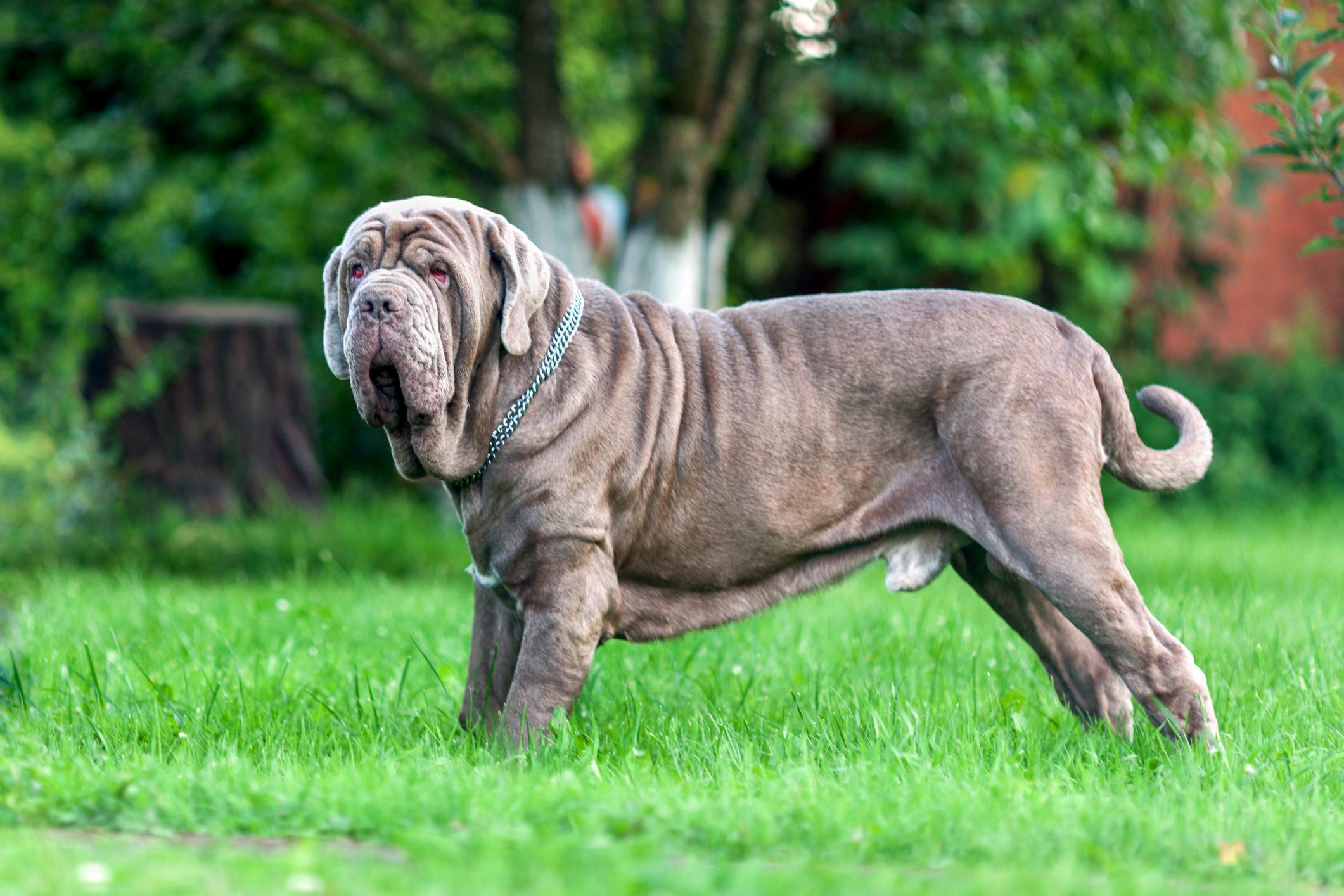
The Neapolitan Mastiff, also known as the Mastino Napoletano, is a large and powerful dog breed that originated in Italy.
Appearance
– The Neapolitan Mastiff is a giant breed, with males weighing between 110-150 pounds (50-68 kg) and standing up to 31 inches (79 cm) tall at the shoulder.
– They have a massive head with a short, wide muzzle and broad nostrils.
– The breed is known for its wrinkled skin, short fur, and long, floppy jowls that droop from its face.
– The coat can be black, blue, mahogany, tawny, or brindle.
Temperament
– The Neapolitan Mastiff is a loyal and protective dog that makes an excellent family companion.
– They can be wary of strangers and other pets, so early socialization and training are important.
– The breed is known for being stubborn and fearless, but also companionable and loving.
– They are low-maintenance and easygoing companions that enjoy spending time with their families.
History
– The Neapolitan Mastiff was originally bred as a family and guard dog in southern Italy.
– The breed’s ancestry is thought to date back to 3000 BCE, during the Bronze Age.
– They were used as war dogs by the ancient Roman army and later as estate guard dogs in Italy.
Care
– The Neapolitan Mastiff is a homebody that enjoys lying around the house all day.
– They require regular exercise and mental stimulation to prevent boredom and destructive behavior.
– The breed is prone to certain health issues, including hip dysplasia, bloat, and eye problems.
Overall, the Neapolitan Mastiff is a gentle giant that requires early socialization and consistent training to ensure a stable temperament. They are known for their loyalty and protective nature, making them a great choice for experienced dog owners who are looking for a devoted companion.
Great Dane
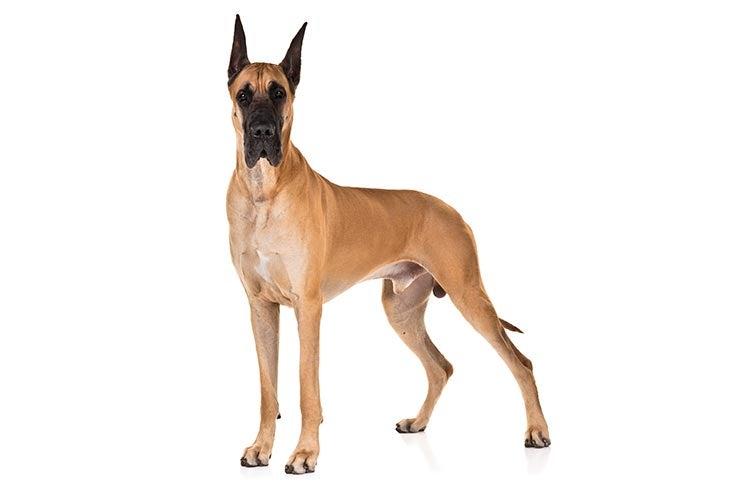
The Great Dane is a large and powerful dog breed that originated in Germany.
Appearance
– The Great Dane is a giant breed, with males standing 30 to 34 inches (76 to 86 cm) tall at the shoulder and weighing between 120-200 pounds (54-91 kg).
– They have a long, narrow head with a deep muzzle and a pronounced stop.
– The breed has a short, smooth coat that can be black, blue, brindle, fawn, harlequin, merle, silver, solid white, or mantle.
– The Great Dane has a muscular and athletic body, with a deep chest and long, powerful legs.
Temperament
– The Great Dane is known for its calm and gentle disposition, often called a “gentle giant”.
– They are affectionate and playful with their families, but can be reserved with strangers.
– The breed is generally good with children and other pets, but early socialization and training are important.
– They are not particularly vocal, but will bark to alert their owners of potential danger.
History
– The Great Dane was originally bred as a hunting dog to hunt wild boar and deer in the Middle Ages.
– The breed was also used as a guardian of German nobility.
– In Germany, the breed is known as the Deutsche Dogge, or German Mastiff.
Care
– The Great Dane is a low-maintenance breed that requires regular exercise and mental stimulation to prevent boredom and destructive behavior.
– They are prone to certain health issues, including hip dysplasia, bloat, and heart problems.
– Consistent training and rules should start right from puppyhood to ensure a well-behaved adult dog.
Overall, the Great Dane is a gentle and affectionate giant that requires early socialization and consistent training to ensure a stable temperament. They are known for their calm and playful nature, making them a great choice for families with children.
Irish Wolfhound
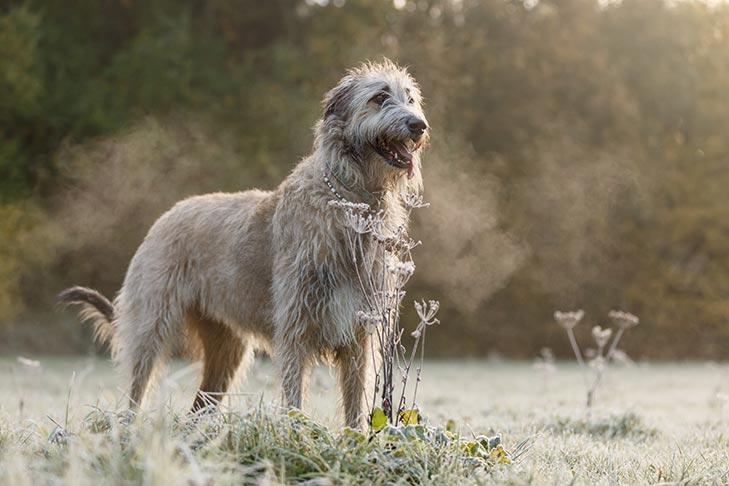
Read more : Can Dogs Eat Sunflower Seeds?
The Irish Wolfhound is a giant breed of dog that originated in Ireland.
Appearance
– The Irish Wolfhound is the tallest of all dog breeds, with males standing at least 32 inches (81 cm) tall at the shoulder and weighing between 120-200 pounds (54-91 kg).
– They have a medium-length, wiry double coat that can be black, blue, brindle, creme, gray, red, silver, white, or wheaten in color.
– The breed has a lanky but muscular build, with long, powerful legs and a deep chest.
Temperament
– The Irish Wolfhound is known for its calm and gentle demeanor, often called a “gentle giant”.
– They are affectionate and loyal to their families, but can be reserved with strangers.
– The breed is generally good with children and other pets, but early socialization and training are important.
– They are not particularly vocal, but will bark to alert their owners of potential danger.
History
– The Irish Wolfhound is an ancient breed that was originally used for hunting wolves, deer, and boar in Ireland.
– The breed was nearly extinct by the 19th century, but was revived by a group of breeders who aimed to recreate the old wolfhounds of Ireland.
– The breed has inspired literature, poetry, and mythology throughout history.
Care
– The Irish Wolfhound is a low-maintenance breed that requires regular exercise and mental stimulation to prevent boredom and destructive behavior.
– They are prone to certain health issues, including heart problems, bloat, and bone cancer.
– Consistent training and rules should start right from puppyhood to ensure a well-behaved adult dog.
Overall, the Irish Wolfhound is a gentle and loyal giant that requires early socialization and consistent training to ensure a stable temperament. They are known for their calm and affectionate nature, making them a great choice for families with children.
Leonberger
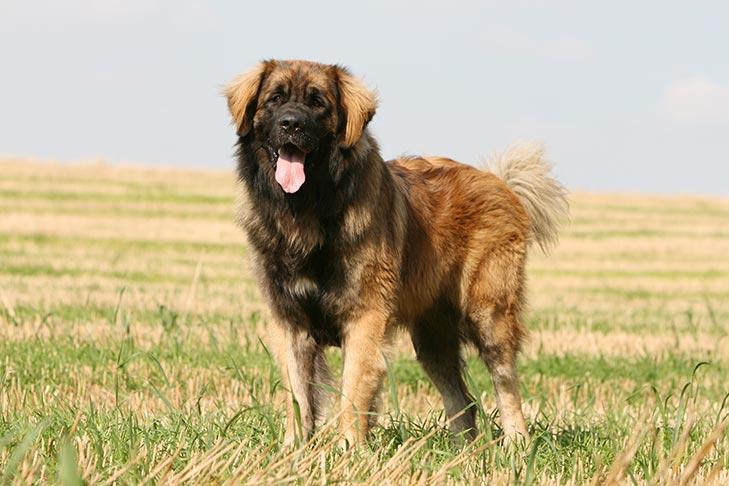
The Leonberger is a giant dog breed that originated in Leonberg, Germany.
Appearance
– The Leonberger is a large and muscular dog, with males standing 28-31 inches (71-80 cm) tall at the shoulder and weighing between 120-170 pounds (54-77 kg).
– They have a double coat that can be lion gold, red, reddish-brown, sandy (fawn or cream), or combinations of these colors, with a black mask.
– The breed has a striking appearance, with a broad head, deep chest, and long, thick fur.
Temperament
– The Leonberger is known for its friendly and loving nature, making it a great family dog.
– They are intelligent and easy to train, but early socialization is important to ensure a stable temperament.
– The breed is generally good with children and other pets, but can be reserved with strangers.
– They are not particularly vocal, but will bark to alert their owners of potential danger.
History
– The Leonberger was originally bred in the mid-19th century by Heinrich Essig, a German breeder who aimed to create a breed that resembled a lion.
– The breed was developed by crossing the Newfoundland, St. Bernard, and Great Pyrenees breeds.
– The Leonberger was used as a working dog for guarding livestock, search and rescue, and as a family companion.
Care
– The Leonberger is a low-maintenance breed that requires regular exercise and mental stimulation to prevent boredom and destructive behavior.
– They are prone to certain health issues, including hip dysplasia, bloat, and heart problems.
– Consistent training and rules should start right from puppyhood to ensure a well-behaved adult dog.
Overall, the Leonberger is a friendly and loving giant that requires early socialization and consistent training to ensure a stable temperament. They are known for their striking appearance and low-maintenance care, making them a great choice for families with children.
Newfoundland
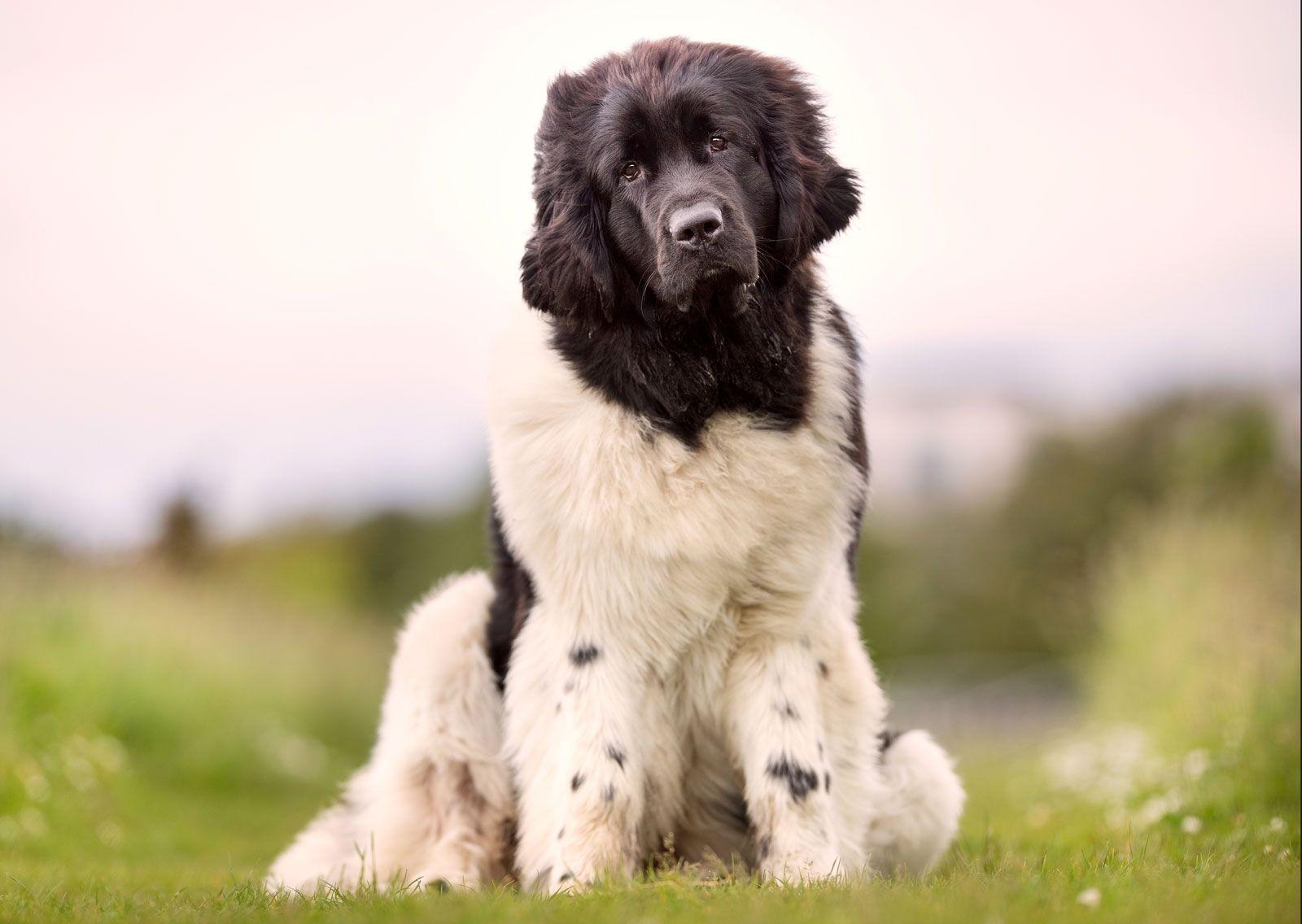
The Newfoundland is a large and noble breed of dog that originated in Newfoundland, Canada.
Appearance
– The Newfoundland is a large and strong dog breed, with males standing 28-31 inches (71-80 cm) tall at the shoulder and weighing between 120-170 pounds (54-77 kg) .
– They have a double coat that can be black, brown, gray, or Landseer (white and black) in color.
– The breed has a broad head, deep chest, and long, thick fur.
Temperament
– The Newfoundland is known for its sweet and gentle disposition, often called a “gentle giant”.
– They are intelligent and easy to train, but early socialization is important to ensure a stable temperament.
– The breed is generally good with children and other pets, but can be reserved with strangers.
– They are not particularly vocal, but will bark to alert their owners of potential danger.
History
– The Newfoundland was originally bred as a working dog to pull nets for fishermen and haul wood from the forest.
– The breed is thought to be a descendant of the Viking “bear dogs” or nomadic Indian dogs.
– They are known for their strength and swimming abilities, making them excellent rescue dogs.
Care
– The Newfoundland is a low-maintenance breed that requires regular exercise and mental stimulation to prevent boredom and destructive behavior.
– They are prone to certain health issues, including hip dysplasia, bloat, and heart problems.
– Consistent training and rules should start right from puppyhood to ensure a well-behaved adult dog.
Overall, the Newfoundland is a sweet and gentle giant that requires early socialization and consistent training to ensure a stable temperament. They are known for their strength and swimming abilities, making them excellent rescue dogs. The breed is low-maintenance and easygoing, making them a great choice for families with children.
Anatolian Shepherd
The Anatolian Shepherd is a large and powerful dog breed that originated in Turkey.
Appearance
– The Anatolian Shepherd is a large and muscular dog, with males standing 28-31 inches (71-80 cm) tall at the shoulder and weighing between 120-170 pounds (54-77 kg).
– They have a double coat that can be black, brown, gray, or Landseer (white and black) in color.
– The breed has a broad head, deep chest, and long, thick fur.
Temperament
– The Anatolian Shepherd is known for its loyalty and protective nature, making it an excellent guard dog.
– They are intelligent and easy to train, but early socialization is important to ensure a stable temperament.
– The breed is generally good with children and other pets, but can be reserved with strangers.
– They are not particularly vocal, but will bark to alert their owners of potential danger.
History
– The Anatolian Shepherd was originally bred as a livestock guardian dog in Turkey, where they were used to protect sheep and goats from predators such as wolves and bears.
– The breed has been used for centuries for this purpose and was developed to live with the flock and adopt it as their own.
– The Anatolian Shepherd is similar to other livestock guardian breeds such as the Great Pyrenees and the Kuvasz.
Care
– The Anatolian Shepherd is a low-maintenance breed that requires regular exercise and mental stimulation to prevent boredom and destructive behavior.
– They are prone to certain health issues, including hip dysplasia, bloat, and heart problems.
– Consistent training and rules should start right from puppyhood to ensure a well-behaved adult dog.
Overall, the Anatolian Shepherd is a loyal and protective dog that requires early socialization and consistent training to ensure a stable temperament. They are known for their strength and protective nature, making them an excellent guard dog. The breed is low-maintenance and easygoing, making them a great choice for families with children.
Bullmastiff
The Bullmastiff is a large and powerful dog breed that originated in England around 1860.
Appearance
– The Bullmastiff is a strong and powerfully built dog, with a large, broad skull and a deep, broad muzzle.
– The breed has a wrinkled forehead and a moderate stop.
– The eyes are medium-sized and dark hazel in color.
– The ears are V-shaped and set high and wide, giving a square appearance to the skull.
– The coat is short and dense, and can be fawn, red, or brindle in color.
Temperament
– The Bullmastiff is known for its loyalty and protective nature, making it an excellent guard dog.
– They are intelligent and easy to train, but early socialization is important to ensure a stable temperament.
– The breed is generally good with children and other pets, but can be reserved with strangers.
– They are not particularly vocal, but will bark to alert their owners of potential danger.
History
– The Bullmastiff was originally bred to help keep large estates and game preserves free of poachers in England.
– The breed was developed by crossing 60% Mastiff and 40% Bulldog, with the goal of creating a dog that was faster and more aggressive than the Mastiff, yet bigger than and not as ferocious as the Bulldog.
– The Bullmastiff is a dog of incredible strength, keen alertness, and surprising endurance.
Care
– The Bullmastiff is a low-maintenance breed that requires regular exercise and mental stimulation to prevent boredom and destructive behavior.
– They are prone to certain health issues, including hip dysplasia, bloat, and heart problems.
– Consistent training and rules should start right from puppyhood to ensure a well-behaved adult dog.
Overall, the Bullmastiff is a loyal and protective dog that requires early socialization and consistent training to ensure a stable temperament. They are known for their strength and protective nature, making them an excellent guard dog. The breed is low-maintenance and easygoing, making them a great choice for families with children.
Tibetan Mastiff
The Tibetan Mastiff is a large and ancient breed of dog that originated in Tibet about 5,000 years ago.
Appearance
– The Tibetan Mastiff is a large and muscular dog, with males standing 26-30 inches (66-76 cm) tall at the shoulder and weighing between 100-160 pounds (45-73 kg).
– They have a thick, double coat that can be black, brown, gray, or gold in color.
– The breed has a broad head, deep chest, and long, thick fur that gives them a lion-like appearance.
Temperament
Read more : 7 Types Of Hunting Dogs
– The Tibetan Mastiff is known for its loyalty and protective nature, making it an excellent guard dog.
– They are intelligent and independent, but early socialization is important to ensure a stable temperament.
– The breed is generally good with children and other pets, but can be reserved with strangers.
– They are not particularly vocal, but will bark to alert their owners of potential danger.
History
– The Tibetan Mastiff is an ancient breed that was originally used as a guard dog for flocks, villages, and monasteries in Tibet.
– The breed was also used as a war dog and was highly valued by the nomadic tribes of Tibet.
– The Tibetan Mastiff is considered to be one of the most ancient breeds worldwide.
Care
– The Tibetan Mastiff is a low-maintenance breed that requires regular exercise and mental stimulation to prevent boredom and destructive behavior.
– They are prone to certain health issues, including hip dysplasia, bloat, and heart problems.
– Consistent training and rules should start right from puppyhood to ensure a well-behaved adult dog.
Overall, the Tibetan Mastiff is a loyal and protective dog that requires early socialization and consistent training to ensure a stable temperament. They are known for their strength and protective nature, making them an excellent guard dog.
The breed is low-maintenance and independent, making them a great choice for experienced dog owners who are looking for a devoted companion.
Dogue de Bordeaux
The Dogue de Bordeaux, also known as the French Mastiff or Bordeauxdog, is a large and muscular dog breed that originated in France.
Appearance
– The Dogue de Bordeaux is a large and muscular dog, with males standing 23-27 inches (58-69 cm) tall at the shoulder and weighing between 99-150 pounds (45-68 kg).
– They have a short, soft coat that can be various shades of fawn, ranging from light to dark red, and small patches of white may be present.
– The breed has a massive head with a prominent forehead, deep wrinkles, and a powerful jaw.
– Their eyes are typically dark and set wide apart, and they have medium-sized ears that hang down.
Temperament
– The Dogue de Bordeaux is known for its loyalty and protective nature, making it an excellent guard dog.
– They are intelligent and independent, but early socialization is important to ensure a stable temperament.
– The breed is generally good with children and family members, but can be confrontational with strangers.
– They are not particularly vocal, but may snore and drool.
History
– The Dogue de Bordeaux is an ancient breed that was used as a cattle driver and personal bodyguard in France.
– The breed was nearly extinct after World War II, but was revived by a group of breeders who aimed to preserve the breed.
– The Dogue de Bordeaux gained popularity in the United States after appearing in the 1989 film “Turner & Hooch”.
Care
– The Dogue de Bordeaux is a low-maintenance breed that requires regular exercise and mental stimulation to prevent boredom and destructive behavior.
– They are prone to certain health issues, including hip dysplasia, bloat, and heart problems.
– Consistent training and rules should start right from puppyhood to ensure a well-behaved adult dog.
Overall, the Dogue de Bordeaux is a loyal and protective dog that requires early socialization and consistent training to ensure a stable temperament. They are known for their strength and protective nature, making them an excellent guard dog.
The breed is low-maintenance and independent, making them a great choice for experienced dog owners who are looking for a devoted companion.
Scottish Deerhound
The Scottish Deerhound is a large breed of sighthound that was originally bred to hunt red deer by coursing.
Appearance
– The Scottish Deerhound is similar in appearance to the Greyhound, but larger and more heavily boned, with a rough coat.
– The breed is one of the tallest sighthounds, with males standing at least 30 inches (75-80 cm) tall at the shoulder and weighing between 85-110 pounds (39-50 kg), and females standing at least 28 inches (71 cm) tall and weighing between 75-95 pounds (34-43 kg).
– They have a harsh 3-4 inch (7.6-10 cm) long coat and mane, with a somewhat softer beard and moustache, and softer hair on the breast and belly.
Temperament
– The Scottish Deerhound is gentle and extremely friendly, with a bearing of gentle dignity.
– The breed is famed for being docile and eager to please.
– They are a true sighthound, which has been bred for centuries to hunt by sight and speed.
– They are not particularly vocal, but will bark to alert their owners of potential danger.
History
– The Scottish Deerhound is an ancient breed that has been around for over 5,000 years.
– The breed was originally used to hunt red deer in Scotland.
– The Scottish Deerhound was once known as the Royal Dog of Scotland.
Care
– The Scottish Deerhound is a low-maintenance breed that requires regular exercise and mental stimulation to prevent boredom and destructive behavior.
– They are prone to certain health issues, including hip dysplasia, bloat, and heart problems.
– Consistent training and rules should start right from puppyhood to ensure a well-behaved adult dog.
Overall, the Scottish Deerhound is a gentle and friendly giant that requires early socialization and consistent training to ensure a stable temperament. They are known for their strength and speed, making them an excellent hunting dog.
The breed is low-maintenance and easygoing, making them a great choice for families with children.
Cane Corso
The Cane Corso is a large and muscular dog breed that originated in Italy.
Appearance
– The Cane Corso is a large and muscular dog, with males standing 23-27 inches (58-69 cm) tall at the shoulder and weighing between 99-150 pounds (45-68 kg).
– They have a short, soft coat that can be various shades of fawn, ranging from light to dark red, and small patches of white may be present.
– The breed has a massive head with a prominent forehead, deep wrinkles, and a powerful jaw.
Temperament
– The Cane Corso is known for its loyalty and protective nature, making it an excellent guard dog.
– They are intelligent and independent, but early socialization is important to ensure a stable temperament.
– The breed is generally good with children and family members, but can be confrontational with strangers.
– They are not particularly vocal, but may snore and drool.
History
– The Cane Corso is an ancient breed that was used as a cattle driver and personal bodyguard in Italy.
– The breed was nearly extinct after World War II, but was revived by a group of breeders who aimed to preserve the breed.
– The Cane Corso gained popularity in the United States in the 1980s.
Care
– The Cane Corso is a low-maintenance breed that requires regular exercise and mental stimulation to prevent boredom and destructive behavior.
– They are prone to certain health issues, including hip dysplasia, bloat, and heart problems.
– Consistent training and rules should start right from puppyhood to ensure a well-behaved adult dog.
Overall, the Cane Corso is a loyal and protective dog that requires early socialization and consistent training to ensure a stable temperament. They are known for their strength and protective nature, making them an excellent guard dog.
The breed is low-maintenance and independent, making them a great choice for experienced dog owners who are looking for a devoted companion.
Bernese Mountain Dog
The Bernese Mountain Dog is a large and muscular dog breed that originated in Switzerland.
Appearance
– The Bernese Mountain Dog is a large dog breed, with males standing 25-27.5 inches (64-70 cm) tall at the shoulder and weighing between 80-115 pounds (36-52 kg), and females standing 23-26 inches (58-66 cm) tall and weighing between 70-95 pounds (32-43 kg).
– They have a thick, medium-length coat that is tricolored, with black, white, and rust markings.
– The breed has a broad head, deep chest, and long, thick fur that gives them a fluffy appearance.
Temperament
– The Bernese Mountain Dog is known for its gentle and affectionate nature, making it a great family pet.
– They are intelligent and easy to train, but early socialization is important to ensure a stable temperament.
– The breed is generally good with children and other pets, and is known for being patient and calm.
– They are not particularly vocal, but may bark to alert their owners of potential danger.
History
– The Bernese Mountain Dog is an ancient breed that was used as a working dog to herd cattle, pull carts, and be watchdogs in Switzerland.
– The breed is one of four types of Swiss Mountain Dogs, and the only one with long hair.
– The Bernese Mountain Dog comes from the canton of Bern, hence their name.
Care
– The Bernese Mountain Dog is a high-maintenance breed that requires regular grooming to prevent matting and shedding.
– They are prone to certain health issues, including hip dysplasia, bloat, and cancer.
– Consistent training and rules should start right from puppyhood to ensure a well-behaved adult dog.
Overall, the Bernese Mountain Dog is a gentle and affectionate dog that requires early socialization and consistent training to ensure a stable temperament. They are known for their strength and working abilities, making them an excellent working dog.
The breed is high-maintenance and requires regular grooming, making them a great choice for experienced dog owners who are willing to put in the time and effort to care for them.
FAQS
1. What is the biggest dog breed in the world?
The biggest dog breed in the world is the English Mastiff, with males weighing between 160-230 pounds and standing up to 30 inches tall at the shoulder.
2. What is the second biggest dog breed in the world?
The second biggest dog breed in the world is the Boerboel, with males weighing between 150-200 pounds.
3. What is the temperament of the biggest dog breeds?
The temperament of the biggest dog breeds can vary, but many are known for being loyal, protective, and gentle with their families.
4. Are the biggest dog breeds good with children?
Many of the biggest dog breeds are good with children and make great family pets, but early socialization and training are important to ensure a stable temperament.
5. What are some common health issues for the biggest dog breeds?
Some common health issues for the biggest dog breeds include hip dysplasia, bloat, and heart problems.
6. Are the biggest dog breeds high-maintenance?
Some of the biggest dog breeds can be high-maintenance, especially when it comes to grooming and exercise requirements.
7. Can the biggest dog breeds live in apartments?
Many apartments and hotels have weight limits for dogs, which giant breeds far exceed, so it can be challenging to find a living situation that accommodates the biggest dog breeds.
8. Are the biggest dog breeds expensive to care for?
Larger dogs often cost more to care for, so be sure to budget for extra food, larger beds, and nutritional supplements, which help keep bigger dogs’ joints healthy.
9. What is the history of the biggest dog breeds?
Many of the biggest dog breeds have a long history of working as guard dogs, herding dogs, and hunting dogs.
10. Are the biggest dog breeds good for first-time dog owners?
The biggest dog breeds may not be the best choice for first-time dog owners, as they require early socialization and consistent training to ensure a stable temperament, and can be high-maintenance.
Source: https://petstutorial.com
Category: DOGS


